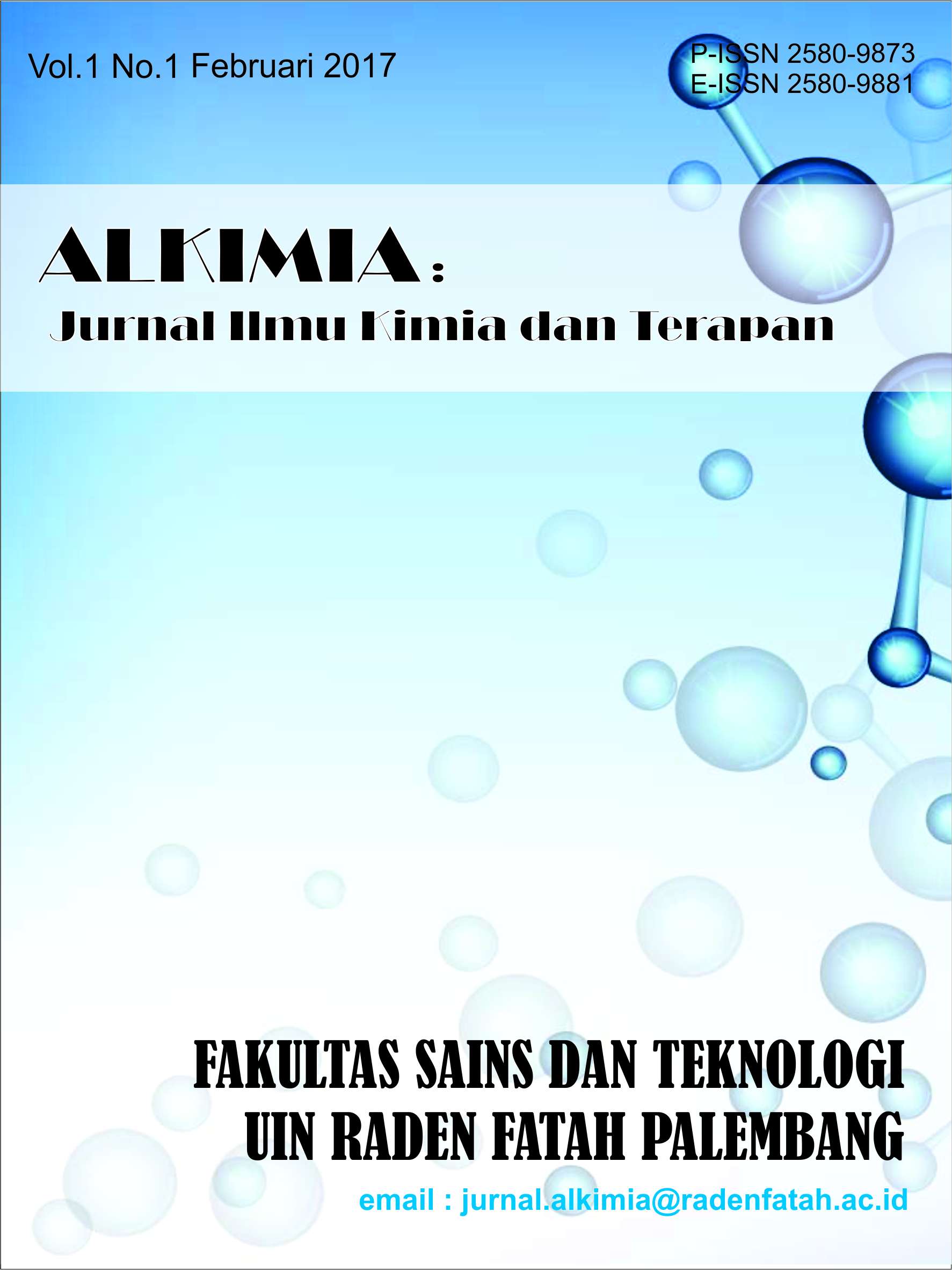Using Susuh Kura (Sulcospira testudinaria) Shell to Mitigate Heavy Metal Pollution in Batanghari River
DOI:
https://doi.org/10.19109/j8ctgs28Keywords:
Adsorption, Snail Shell, ICP-MS, Heavy Metals, Batanghari River, SEMAbstract
The Batanghari River, as the primary water source for the Jambi City Water Utility (PDAM), has been subjected to pollution caused by anthropogenic activities, particularly those stemming from industrial, agricultural, and domestic sectors. Concentrations of heavy metals such as mercury (Hg), cadmium (Cd), copper (Cu), lead (Pb), and zinc (Zn) have been detected at levels exceeding the limits established by Government Regulation No. 22 of 2021. This research aimed to mitigate the presence of heavy metals in the Batanghari River through adsorption techniques utilizing Susuh kura snail shells as a natural adsorbent. The characterization of the adsorbent was conducted using Scanning Electron Microscopy (SEM) to analyze its morphology and Inductively Coupled Plasma Mass Spectrometry (ICP-MS) to assess the heavy metal content in the river water. The snail shells were treated under varying thermal conditions: uncalcined, and calcined at 500 °C and 700 °C. The results indicated that calcium oxide (CaO) derived from shells calcined at 500 °C exhibited the highest adsorption efficiency, achieving up to 80% reduction in heavy metal concentrations. These findings suggest that waste snail shells possess significant potential as a low-cost, eco-friendly natural adsorbent for addressing heavy metal contamination in aquatic environments, offering a sustainable solution for water treatment.
References
Yulita, O, “The Role of the Batanghari River in the Economy of the Jambi Malay Sultanate.” Hadharah: Journal of Islam and Civilization, vol. 14, pp. 97–108, 2020.
Yunina, A. D. Moelyaningrum, and E. Ellyke, “Utilization of Coconut Shell (Cocos nucifera) Activated Charcoal to Bind Chromium (Cr) (A Study on Batik Liquid Waste)”, vol. 21, no. 1, pp. 93–98, 2022, doi: 10.14710/jkli.21.1.93-98.
Pratiwi, D. Y. “The Impact of Heavy Metal Pollution (Lead, Copper, Mercury, Cadmium, Chromium) on Aquatic Organisms and Human Health” 2020.
Rahayu, M. S. D.R., “Bioaugmentation Study to Reduce Heavy Metal Concentrations in Water Areas Using Bacteria,” ITS Engineering Journal,11(1), 15=22.15-22, 2022.
Anwar, K., Mardiyono, M., & Harmastuti, N. (2022). Characteristics of Breadfruit Peel Pectin (Artocarpus altilis (Park.) Fosberg) and Heavy Metal Adsorption Capacity Test on Stifera Semarang Laboratory Waste. Scientific Journal of Science, 22(1), 8. https://doi.org/10.35799/jis.v22i1.35537
Nurfauziah, R., Fadillah, Z. R., Setyaningrum, S., & Andrijanto, E. (2021). Adsorption of Cu Metal with Graphene Oxide. Fullerene Journ. Of Chem, 6(2), 96–100. https://doi.org/10.37033/fjc.v6i2.326
Diah Ivontianti, W. S. Khairi, R. Devitasari, and D. Yusup, “Utilization of Snail Shells (Sulcospira Testudinaria) as Adsorbents to Absorb Iron (Fe) in Waters with a Study of Adsorbent Calcination Temperature Variations,” 2022.
Herlianto, W. (2021). 5 Merangin Jambi specialties you should try, with unique names. tribunjambitrevel.com.
Silalahi, A. M., Fadholah, A., & Artanti, L. O. (2020). Turtle shell (Sulcospira testudinaria). | Pharmasipha, 4(1), 1–9.
Utami, W., Noviarni, I., Rizal, F., Risa Primarani, N, “Lead Removal Using Biosorbent from Sulcospira testudinaria Shells”, Engineering Headway, 2025. Vol. 25, pp 41-48. doi: https://doi.org/10.4028/p-eDQd1R
Yantyana, I. V. Amalia, and R. Fitriyani, “Adsorption of Lead (II) Metal Ions Using Ca-Alginate Microcapsules” al-Kimiya, vol. 5, no. 1, pp. 17–26, 2018, doi: 10.15575/ak.v5i1.3721.
Arrizal, H. S. Maftukhah, and D. Agustine, “Potential of Chicken Eggshell Waste as Manganese (Mn) Metal Biosorbent and Its Comparison with Chemical Coagulants” Jurnal Teknik & Teknologi Terapan, vol. 2, no. 2, 2024.
Ashrit, S. R. V. Chatti, S. Sarkar, R. Venugopal, and G. Udayabhanu Nair, “Application of ICP-MS technique for analysis of heavy metals in LD slag fines,” Curr Sci, vol. 115, no. 5, pp. 973–977, 2018, doi: 10.18520/cs/v115/i5/973-977.
Yanova, S. K. A. M. Siagian, and R. Gusanti, “Heavy Metal Contamination Levels in Batanghari River Water, Jambi Province Based on the C/P (Contamination/Pollution) Index” Jurnal Daur Lingkungan, vol. 3, no. 2, p. 62, 2020, doi: 10.33087/daurling.v3i2.56.
Istarani F. and E. Pandebesie, “Study of the Impact of Arsenic (As) and Cadmium (Cd) on Environmental Quality Decline” Jurnal Teknik Pomit, vol. 3, 2014.
Yantyana I. et al., “Adsorption of Lead Metal Ions (Ii) Using Ca-Alginate Microcapsules,” 2018.
Zhang, Y., et al. (2019). "Thermal Activation of Biochars: Enhancement of Adsorption Capacity for Heavy Metal Ions." Journal of Environmental Chemical Engineering, 7(4), 103247.
Wiyantoko, B., Kurniawati, P., Purbaningtias, T.,” Assessing the effect of calcination on adsorption capability of Mg/Al layer double hydroxides (LDHs)”. Mater. Res. Express 9 (2022) 035505
Ulfiati, R., Safitri, L., Rozaq, M.F., Harjanto, S., Nurjaya, DM. “ The calcination temperature effects on the adsorption characteristics of Badau Belitung kaolin”. AIP Conf. Proc. 2538, 020009 (2023).
Mansour, H. F. Awad, M. Saber, and A. Zaghloul, “Effect of contamination sources on the rate of zinc, copper and nickel release from various soil ecosystems,” Bull Natl Res Cent, vol. 44, no. 1, Dec. 2020, doi: 10.1186/s42269-020-00431-8.
Rahmawati, I., Pramudito, S. A., & Yuliani, E. (2020). " Utilization of CaO from shell waste as an adsorbent for heavy metal ions." Jurnal Rekayasa Material, 8(1), 22–28.
Chen, H., Zhao, J., & Xu, P. (2018). "Thermal activation of calcium-based adsorbents for heavy metal removal in water." Applied Surface Science, 456, 365–373.
Budianta W. and R. N. Tadersi, “Heavy Metal Pollution in River Sediments on Tin Mining Location at Pakil River, Bangka, Indonesia,” in Proceedings of the International Conference on Sustainable Environment, Agriculture and Tourism (ICOSEAT 2022), Atlantis Press, Jan. 2023. doi: 10.2991/978-94-6463-086-2_89.
Downloads
Published
Issue
Section
License
Copyright (c) 2024 Andi Halomoan Lubis, Lidia Gusfi Marni, Syukrya Ningsih, Dandy Firmansyah Rifli

This work is licensed under a Creative Commons Attribution-ShareAlike 4.0 International License.
- The author saves the copyright and gives the journal simultaneously with the license under Creative Commons Attribution License which permits other people to share the work by stating that it is firstly published in this journal.
- The author can post their work in an institutional repository or publish it in a book by by stating that it is firstly published in this journal.
- The author is allowed to post their work online (for instance, in an institutional repository or their own website) before and during the process of delivery. (see Open Access Effect).







.png)




